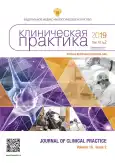The effectiveness of the surgical correction of the temporomandibular joint intracapsular disorders
- Authors: Lyashev I.N.1, Dybov A.M.2, Kholmogorova P.V.2
-
Affiliations:
- Clinical Centre of Otorhinolaryngology of Federal Medical Biological Agency of Russia
- I.M. Sechenov First Moscow State Medical University of the Ministry of Health of the Russian Federation (Sechenov University)
- Issue: Vol 10, No 2 (2019)
- Pages: 6-13
- Section: Original Study Articles
- URL: https://journals.rcsi.science/clinpractice/article/view/14553
- DOI: https://doi.org/10.17816/clinpract1026-13
- ID: 14553
Cite item
Full Text
Abstract
Background. The prevalence of temporomandibular joint diseases covers about 40% of the population. The main place (from 70 to 82%) among these diseases is occupied by the so-called intracapsular disorders of the temporomandibular joint (TMJ). The lack of consensus on the use of treatment methods and clear protocols for the rehabilitation of patients with intracapsular TMJ disorders was the basis for the conduct of this study.
Objective. The purpose of the study was to analyze the treatment effectiveness in patients with intracapsular disorders of the temporomandibular joint using the complex of pathogenetically substantiated conservative and surgical methods. Methods. The research included 43 patients with complaints to pains and dysfunction of TMJ. Everything fulfilled the uniform protocol of inspection. Depending on disease degree to patients were assigned or a course of conservative treatment with use splint therapy, or surgical correction of defect.
Results. After analyzing the dynamics of patient treatment in the framework of this study, it was found that surgical correction of intracapsular disorders of the temporomandibular joint was effective in all patients examined by us.
Conclusion. To maintain a long-term stable result, this group of patients is shown orthodontic-orthopedic rehabilitation, with the goal of creating and maintaining correct occlusal relationships.
Full Text
##article.viewOnOriginalSite##About the authors
Ilya N. Lyashev
Clinical Centre of Otorhinolaryngology of Federal Medical Biological Agency of Russia
Author for correspondence.
Email: mfsurg@gmail.com
ORCID iD: 0000-0001-7173-3111
Maxillofacial surgeon
Russian Federation, MoscowAndrey M. Dybov
I.M. Sechenov First Moscow State Medical University of the Ministry of Health of the Russian Federation (Sechenov University)
Email: andybov@gmail.com
ORCID iD: 0000-0002-2932-168X
assistant professor, Candidate of Medical Sciences, ortodontist
Russian Federation, МoscowPolina V. Kholmogorova
I.M. Sechenov First Moscow State Medical University of the Ministry of Health of the Russian Federation (Sechenov University)
Email: kholmogorova.polina@bk.ru
ORCID iD: 0000-0003-4647-1345
ординатор кафедры стоматологии детского возраста и ортодонтии
Russian Federation, МoscowReferences
- Сысолятин П.Г., Ильин A.A. Показания и выбор хирургических мероприятий в комплексном лечении дисфункции височно-нижнечелюстного сустава. В сб.: Заболевания височно-нижнечелюстного сустава. / Под ред. В.А. Хватовой. — М.: Медицина, 1982. — С. 16-20. (Серия «Б-ка практ. врача»). [Sysolyatin PG, Il'in AA. Pokazaniya i vybor khirurgicheskikh meropriyatij v kompleksnom lechenii disfunktsii visochno-nizhnechelyustnogo sustava. In: Zabolevaniya visochno-nizhnechelyustnogo sustava. Ed by V.A. Khvatovа. Moscow: Meditsina; 1982. рр. 16-20. (Seriya «B-ka prakt. vracha»). (In Russ).]
- Ильин AA. Хирургическое лечение дисфункций височно-нижнечелюстного сустава. / Полвека на страже здоровья: Материалы докладов научно-практической конференции, посвященной 50-летию Областной клинической больницы. — Новосибирск: СО АМН СССР, 1989. — С. 132-133. [Il'in AA. Khirurgicheskoe lechenie disfunktsij visochno-nizhnechelyustnogo sustava. (Conference proceedings) Polveka na strazhe zdorov'ya: Materialy dokladov nauchno-prakticheskoj konferentsii, posvyashchennoj 50-letiyu Oblastnoj klinicheskoj bol'nitsy. Novosibirsk: SO AMN SSSR; 1989. рр. 132-133. (In Russ).]
- Коротких Н.Г., Морозов А.Н., Келейникова В.А. Артроскопия в диагностике и лечении травматических повреждений височно-нижнечелюстного сустава // Вестник новых медицинских технологий. — 2012. — Т.XIX. — №2. — С. 289-291. [Korotkikh NG, Morozov AN, Keleinikova VA. Arthroscopy in the diagnosis and treatment of traumatic injuries of the temporomandibular joint. Vestnik Novykh Meditsinskikh Tekhnologii. 2012;XIX(2):289-291. (In Russ).]
- Sysolatin PG, Ilyin AA. Treatment of internal derangevents of TMJ using microsurgical technique II. The internal ass. for max-fac.surg. Seattle, Washington, USA; 1992. Р. 21.
- Sysolatin PG, Ilyin АА, Ishenko NA, Makarova IA. Unqueshot inguries of the temporomandibular joint and their treatment II 17-th Congress of international 3ss.for max-fac.surg. St.-Petersburg; 1992. рр. 71-72.
- Katzberg RW, Westesson PL, Tallents RH, et al. Temporomandibular joint: MR assessment of rotational and sideways disk displacements. Radiology. 1988;169(3):741-748. doi: 10.1148/radiology.169.3.3186996.
- Clark GT, Delcanho RE, Goulet JP. The utility and validity of current diagnostic procedures for defining temporomandibular disorder patients. Adv Dent Res. 1993;7(2):97-112. doi: 10.1177/08959374930070022101.
- Parvizi J, Zmistowski B, Berbari EF et al. New definition for periprosthetic joint infection: from the workgroup of the musculoskeletal infection society. Clin Orthop Relat Res. 2011;469(11):2992-2994. doi: 10.1007/s11999-011-2102-9.
- Mercuri LG, Giobbe-Hurder A. Long-term outcomes after total alloplastic temporomandibular joint reconstruction following exposure to failed materials. J Oral Maxillofac Surg. 2004;62:1088-96.
- Yura S, Totsuka Y, Yoshikawa T, Inoue N. Can arthrocentesis release intracapsular adhesions? Arthroscopic findings before and after irrigation under sufficient hydraulic pressure. J Oral Maxillofac Surg. 2003;61(11):1253-1256.
- Яременко А.И., Королев В.О. Малоинвазивные хирургические методики лечения заболеваний височно-нижнечелюстного сустава. Обзор научной литературы // Вестник Новгородского государственного университета им. Ярослава Мудрого. — 2015. — №2. — С. 93-95. [Iaremenko AI, Korolev VO. Minimally invasive tmj-surgery methods. review of scientific literature. Vestnik Novgorodskogo gosudarstvennogo universiteta im. Yaroslava Mudrogo. 2015;(2):93-95. (In Russ).]
- Anderson QN, Katzberg RW. Patologic evaluation of disk dysfunction and osseus abnormalities of the temporomandibular joint. J Oral Maxillofac Surg. 1985;43(12):947-951. doi: 10.1016/0278-2391(85)90008-4.
- Kowalchuk RM, Kaplan-List K, Caplash JM, Block P. Temporomandibular joint (TMJ) Internal Derangement Score (TIDS): a New MRI-Based Scoring System for TMJ Internal Derangement: patient stratification based on the degree of TMJ pathology can help guide the most appropriate treatment ACR Annual Meeting and Chapter Leadership Conference (AMCLC). Washington, D.C.; 2014.
- Larheim TA, Katzberg RW, Westesson PL, et al. MR evidence of temporomandibular joint fluid and condyle marrow alterations: occurrence in asymptomatic volunteers and symptomatic patients. Int J Oral Maxillofac Surg. 2001;30(2):113-117. doi: 10.1054/ijom.2000.0018.
- Tomas X, Pomes J, Berenguer J, et al. MR imaging of temporomandibular joint dysfunction: a pictorial review. Radiographics. 2006;26(3):765-781. doi: 10.1148/rg.263055091.
- El-Essawy M, Al-Nakshabandi N, Al-Boukai A. Magnetic resonance imaging evaluation of temproman-dibular joint derangement in symptomatic and asymptomatic patients. Saudi Med J. 2008;29(10):1448-1452.
- Wilkes CH. Internal derangements of the temporomandibular joint. Pathological variations. Arch Otolaryngol Head Neck Surg. 1989;115(4):469-477. doi: 10.1001/archotol.1989.01860280067019.
Supplementary files










